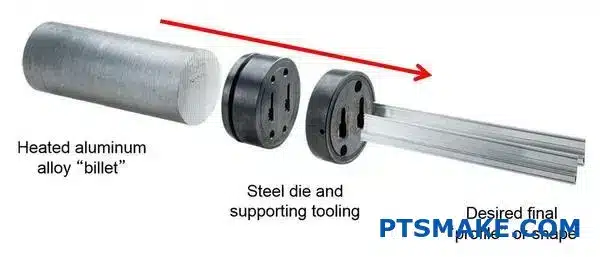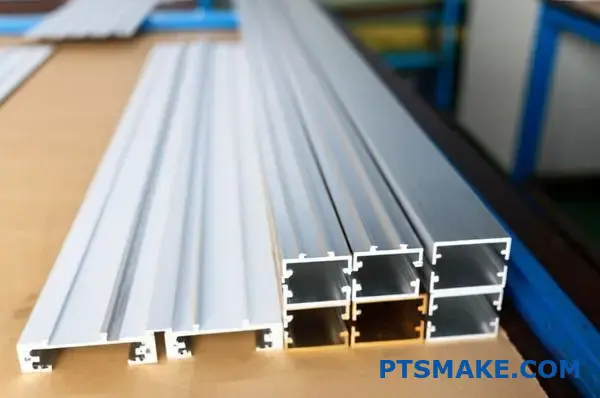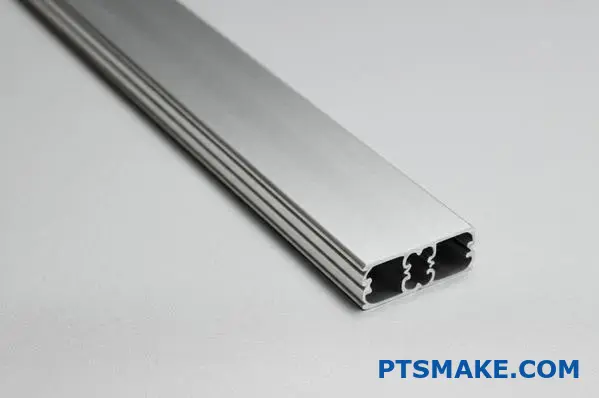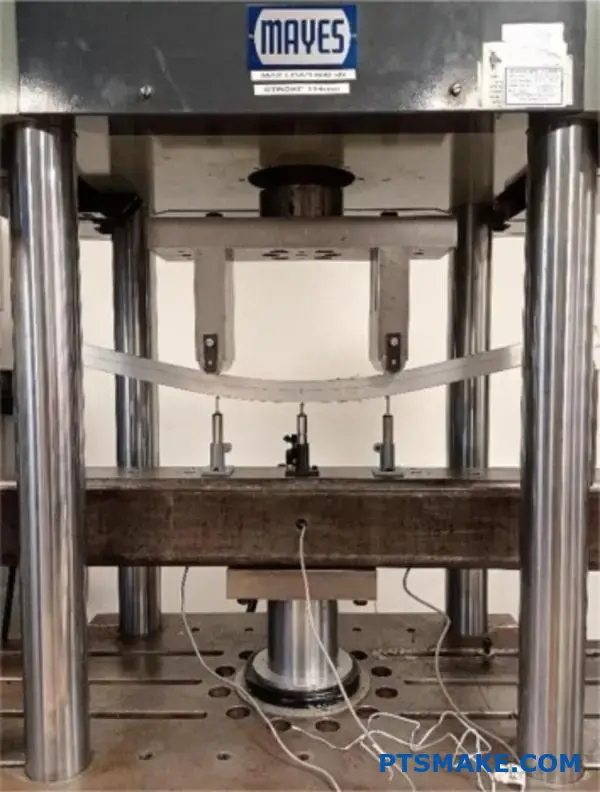Finding reliable CNC machining services can be extremely challenging. Many businesses have been burned by poor quality, missed deadlines, and communication barriers when working with overseas manufacturers, leaving them hesitant to consider Chinese suppliers despite potential cost benefits.
Chinese CNC machining quality has improved dramatically in the last decade. Modern Chinese CNC manufacturers now offer precision comparable to Western standards, with many facilities utilizing the same advanced German and Japanese equipment, ISO certifications, and rigorous quality control procedures.

I’ve personally witnessed this transformation at PTSMAKE. We’ve invested heavily in top-tier equipment and quality management systems that allow us to produce parts with tolerances as tight as ±0.005mm. Our customers are often surprised when they first receive our samples, expecting lower quality but getting precision parts that meet or exceed their specifications. If you’re wondering whether Chinese CNC machining is right for your project, let me share some insights that might help you make an informed decision.
What Certifications Ensure Quality In Chinese CNC Machining?
Have you ever received a batch of CNC machined parts from China only to discover they don’t meet your specifications? Or worse, wondered if your manufacturing partner actually adheres to international quality standards despite their claims? These uncertainties can keep any product engineer or procurement manager awake at night.
Chinese CNC machining providers typically demonstrate quality commitment through certifications like ISO 9001, ISO/TS 16949, AS9100, ISO 13485, and GMP. These internationally recognized standards verify that manufacturers maintain consistent quality systems, proper documentation, and continuous improvement processes essential for reliable part production.

Why Certifications Matter in Chinese CNC Manufacturing
When sourcing precision-machined parts from China, certifications serve as your first line of defense against quality issues. They’re not just fancy documents hanging on office walls – they represent a manufacturer’s commitment to following standardized processes and meeting specific industry requirements.
In my experience working with hundreds of clients at PTSMAKE, I’ve found that understanding certifications gives you tremendous leverage when selecting a Chinese manufacturing partner. These credentials provide objective verification that a supplier can consistently deliver quality products according to international standards.
Core Quality Certifications for Chinese CNC Machining Companies
ISO 9001: The Foundation of Quality Management
ISO 9001 is the cornerstone certification for any reputable Chinese CNC machining company. This standard establishes the criteria for a quality management system based on principles including:
- Strong customer focus
- Top management involvement
- Process-based approach
- Continuous improvement
- Evidence-based decision making
When a Chinese manufacturer holds a current ISO 9001 certification, it means they’ve implemented systematic controls to ensure consistent product quality. This certification is particularly important because it requires regular third-party audits to verify compliance.
ISO/TS 16949 (Now IATF 16949): Automotive Industry Excellence
For automotive components, the IATF 16949 certification (which replaced ISO/TS 16949) is essential when working with Chinese CNC shops. This standard includes all ISO 9001 requirements plus additional automotive-specific qualifications.
Chinese machining companies with this certification demonstrate:
- Defect prevention capabilities
- Reduction of variation and waste
- Control over automotive supply chain processes
- Implementation of automotive-specific tools and techniques
AS9100: Aerospace Requirements
When sourcing aerospace components from Chinese manufacturers, AS9100 certification is non-negotiable. This standard includes ISO 9001 requirements plus additional criteria specific to aviation, space, and defense industries.
A Chinese CNC shop with AS9100 certification has demonstrated:
- Enhanced product safety measures
- Rigorous risk management protocols
- Configuration management capabilities
- Special process controls
ISO 13485: Medical Device Manufacturing
For medical device components, ISO 13485 certification ensures Chinese manufacturers meet the stringent regulatory requirements of the medical industry. This standard focuses on:
- Risk management throughout product lifecycle
- Validation of special processes
- Control of contamination and cleanliness
- Comprehensive documentation and traceability
Environmental and Sustainability Certifications
Beyond quality management, environmental certifications like ISO 14001 demonstrate a Chinese manufacturer’s commitment to sustainable practices. This certification verifies that a company:
- Minimizes environmental impact
- Complies with applicable laws and regulations
- Continuously improves environmental performance
- Properly handles waste and hazardous materials1
Verification of Certifications: Beyond Paper Claims
One challenge when working with Chinese CNC machining providers is verifying the authenticity of claimed certifications. I recommend these verification steps:
- Request certificate copies and check expiration dates
- Verify certification through the issuing body’s database
- Look for the certification body’s accreditation information
- Request recent audit reports and corrective actions
At PTSMAKE, we maintain current certificates with all relevant accreditation information available to clients upon request. This transparency is something you should expect from any quality-focused Chinese manufacturer.
Industry-Specific Certifications by Application
Different applications require specific certifications to ensure components meet industry standards:
| Industry | Essential Certifications | Additional Recommended Certifications |
|---|---|---|
| Automotive | IATF 16949 | ISO 14001, PPAP capability |
| Aerospace | AS9100 | Nadcap for special processes |
| Medical | ISO 13485 | GMP, FDA registration |
| Electronics | ISO 9001 | IPC standards, RoHS, REACH |
| Industrial | ISO 9001 | Industry-specific standards |
The Relationship Between Certifications and Manufacturing Capabilities
It’s important to understand that certifications, while crucial, represent only part of a Chinese manufacturer’s quality capabilities. The true value comes from how they implement these standards in daily operations.
When evaluating potential Chinese CNC machining partners, I suggest looking beyond certificates to assess:
- Quality control processes and inspection equipment
- Manufacturing technology and machinery condition
- Staff training and technical expertise
- Problem-solving methodologies
- Communication systems and responsiveness
The best Chinese manufacturers view certifications as minimum requirements rather than achievements – they’re simply the foundation upon which excellence is built.
How Does Chinese CNC Machining Compare In Cost To Other Countries?
Have you ever received manufacturing quotes that left you stunned? Perhaps you’ve compared prices between domestic and international CNC machining services and wondered why the differences are so dramatic? Cost variations in global manufacturing can be puzzling, especially when project budgets are tight.
Chinese CNC machining typically costs 30-50% less than Western counterparts due to lower labor costs, government subsidies, established supply chains, and operational efficiencies. However, these savings must be balanced against shipping times, quality control needs, and intellectual property considerations.
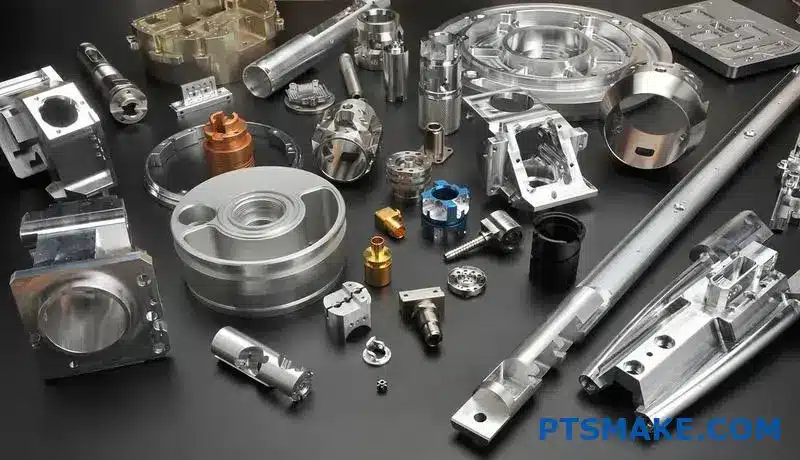
Labor Cost Differences
The most significant factor driving China’s price advantage in CNC machining is labor costs. Having worked with manufacturing facilities across multiple continents, I can confirm that Chinese machinist wages remain substantially lower than those in Western countries. This doesn’t mean less skilled labor—quite the contrary.
In the United States, skilled CNC operators can earn $25-35 per hour, while their counterparts in Western Europe might earn €20-30 per hour. By comparison, Chinese machinists typically earn the equivalent of $3-8 per hour, depending on experience and region. This dramatic difference doesn’t just affect direct machining costs but extends to all aspects of production.
At PTSMAKE, we maintain a team of highly qualified CNC specialists who deliver precision parts at competitive rates. The labor cost advantage allows us to provide more attentive service without the premium pricing found elsewhere.
Manufacturing Ecosystem Advantages
China’s manufacturing ecosystem has evolved into a remarkably efficient network that few countries can match. This industrial agglomeration2 creates cost savings that go beyond labor.
Raw Material Accessibility
China has developed extensive supply chains for materials commonly used in CNC machining:
| Material Type | China Price Advantage | Key Factors |
|---|---|---|
| Aluminum | 15-25% lower | Local production, volume purchasing |
| Steel | 10-20% lower | Domestic steel industry, reduced logistics |
| Plastics | 20-30% lower | Petrochemical industry proximity |
These materials flow seamlessly to manufacturing hubs without the lengthy supply chains and multiple markups seen in other countries.
Equipment and Technology Investment
Despite common misconceptions, Chinese CNC facilities often utilize cutting-edge equipment. Government initiatives have encouraged manufacturing technology investment, resulting in modern machine parks at lower operational costs.
At PTSMAKE, we regularly upgrade our Haas, DMG MORI, and Mazak CNC centers—the same brands used in top Western facilities—but our investment costs are amortized differently due to various government programs supporting manufacturing advancement.
Operational Efficiency Factors
Production Volumes and Economies of Scale
China’s manufacturing prowess creates natural economies of scale. Most facilities run multiple shifts, sometimes 24/7, maximizing equipment utilization. In my experience working with both Western and Chinese facilities, I’ve noticed Chinese shops often operate at 80-90% capacity utilization versus 60-70% at many Western counterparts.
Overhead Costs
The overall business operation costs in China remain lower:
- Facility costs (rent, utilities) typically 60-70% less than in the US
- Lower regulatory compliance costs
- Streamlined business operations focused on manufacturing efficiency
- Reduced insurance and related business expenses
These savings translate directly to the bottom line of project quotes.
Quality Considerations vs. Cost
A common concern when discussing Chinese manufacturing is quality. In my 15+ years in the industry, I’ve seen remarkable improvements. Today, the quality gap between Chinese and Western manufacturing has narrowed significantly, especially at established companies.
Quality Control Systems
At PTSMAKE, we implement:
- ISO 9001:2015 quality management standards
- 100% inspection protocols for critical dimensions
- Advanced CMM (Coordinate Measuring Machine) verification
- Comprehensive material certifications
These systems ensure parts manufactured in our Chinese facilities meet or exceed international standards while maintaining cost advantages.
Total Cost Analysis: Beyond the Quote
When comparing CNC machining costs internationally, it’s essential to consider the total cost, not just the quoted price:
| Cost Component | China | United States | Germany |
|---|---|---|---|
| Base machining | 100% | 180-250% | 200-270% |
| Shipping | 5-15% | 1-3% | 1-3% |
| Customs/Duties | 0-25% | 0-5% | 0-5% |
| Quality control | 5-10% | 3-5% | 3-5% |
| Project management | 5-10% | 5-8% | 5-8% |
While Chinese manufacturing quotes typically show substantial savings, some additional costs can narrow this gap. However, even with these considerations, the typical total cost advantage remains 25-40% for most projects.
I’ve found that clients who establish clear communication channels and develop strong relationships with their Chinese manufacturing partners can maximize cost benefits while minimizing potential challenges.
What Lead Times Can Be Expected From CNC Machining China Suppliers?
Have you ever placed an order with a Chinese CNC supplier, only to be left wondering when your parts will actually arrive? Or perhaps you’ve been frustrated by vague delivery promises that leave your production schedule in limbo?
Most CNC machining suppliers in China offer lead times ranging from 3-15 days for standard parts, while complex projects may take 2-4 weeks. Factors affecting these timelines include part complexity, material availability, quality requirements, order volume, and current production capacity.

Key Factors That Influence CNC Machining Lead Times
When discussing lead times for CNC machining in China, it’s essential to understand the various factors that can either shorten or extend your waiting period. Based on my experience working with hundreds of clients at PTSMAKE, I’ve identified several critical factors that consistently impact delivery schedules.
1. Part Complexity and Design Specifications
The complexity of your part plays a significant role in determining lead time. Simple parts with few features can often be machined quickly, while complex geometries requiring multiple setups, specialty tooling, or 5-axis machining will naturally take longer.
Some complexity factors that extend lead times include:
- Multiple machining operations requiring repositioning
- Tight tolerances (±0.01mm or less)
- Intricate features such as thin walls or deep cavities
- Surface finish requirements3 beyond standard machining
For example, a simple aluminum bracket might be completed in 3-5 days, while a complex medical device component with multiple critical dimensions could require 10-14 days or more.
2. Material Selection and Availability
The material you choose significantly impacts lead time. Common materials like aluminum, mild steel, and standard plastics are typically stocked by reputable suppliers and won’t add delays. However, specialty materials can add days or even weeks to your timeline.
Common material-related delays include:
| Material Type | Typical Additional Lead Time | Reason |
|---|---|---|
| Standard (6061 Aluminum, 1045 Steel) | 0 days | Readily available in stock |
| Less Common (17-4 PH Stainless, Titanium) | 3-7 days | Limited stock, may require ordering |
| Exotic (Inconel, Hastelloy) | 7-14+ days | Rarely stocked, special order required |
| Custom Plastics | 5-10+ days | Special order and potential import requirements |
At PTSMAKE, we maintain a large inventory of commonly used materials to minimize these delays, but it’s always wise to check material availability early in your project planning.
3. Quality Requirements and Inspection Processes
Higher quality standards require additional inspection and quality control processes, which add time to your order. These might include:
- CMM (Coordinate Measuring Machine) inspection for critical dimensions
- Material certifications and testing
- First article inspection reports
- Surface treatment quality checks
For mission-critical components in aerospace or medical applications, these quality processes are non-negotiable and must be factored into lead time expectations.
4. Order Quantity and Production Volume
The relationship between quantity and lead time isn’t always linear. Consider these general guidelines:
- Prototypes (1-5 pieces): 3-7 days for simple parts
- Small production runs (10-50 pieces): 7-14 days
- Medium production runs (50-500 pieces): 14-21 days
- Large production runs (500+ pieces): 21+ days
However, economies of scale can sometimes work in your favor. For larger orders, suppliers like PTSMAKE might dedicate specific machines or production lines to your project, potentially reducing per-unit production time.
Comparing Standard Lead Times Across Chinese CNC Suppliers
In my experience working with various suppliers across China, I’ve noticed some regional and company-size differences that affect lead times:
By Supplier Size:
| Supplier Type | Typical Lead Times | Advantages | Limitations |
|---|---|---|---|
| Small Workshops | 5-10 days (simple parts) | Flexible, personal attention | Limited capacity, less consistent |
| Mid-sized Manufacturers | 7-14 days | Good balance of capacity and attention | May prioritize larger clients |
| Large Factories | 10-21 days | High capacity, comprehensive capabilities | Less flexibility, longer communication chains |
By Region:
Different manufacturing regions in China have developed specialized capabilities:
- Pearl River Delta (Shenzhen, Dongguan): Generally offers the fastest lead times (5-10 days) due to concentrated supply chains and specialized facilities
- Yangtze River Delta (Shanghai region): Slightly longer lead times (7-14 days) but often higher precision capabilities
- Central China: Can offer competitive pricing but typically longer lead times (10-21 days) due to logistics challenges
Strategies to Reduce CNC Machining Lead Times
Based on my experience helping clients optimize their manufacturing processes, here are practical strategies to reduce lead times:
Design for manufacturability (DFM) – Simple adjustments like standardizing corner radii or avoiding unnecessarily tight tolerances can dramatically reduce machining time.
Provide complete technical information upfront – Incomplete drawings or specifications inevitably lead to questions and delays.
Consider material substitutions – Sometimes an equally functional but more readily available material can save weeks of waiting.
Split your order strategically – If you need some parts urgently, consider having a small batch air-shipped while the remainder comes by sea.
Build a relationship with your supplier – Long-term partners like PTSMAKE will often prioritize established customers during busy periods.
The Reality of Lead Time Promises
It’s important to understand that quoted lead times and actual delivery dates can sometimes differ. A reputable supplier should provide realistic estimates and communicate proactively about any potential delays.
When comparing suppliers, be wary of promises that seem too good to be true. A supplier claiming to deliver complex parts in just 2-3 days might be overpromising to win your business.
At PTSMAKE, we’ve built our reputation on setting realistic expectations and then meeting or exceeding them. We’d rather quote you an honest timeline than risk disappointing you with delays that impact your production schedule.
What Communication Support Exists For Overseas CNC Machining Clients?
Have you ever placed an order with an overseas manufacturer only to be left in the dark about your project status? Or struggled to explain complex technical requirements across time zones and language barriers? These communication challenges can turn promising international manufacturing partnerships into frustrating experiences.
Effective communication support for overseas CNC machining clients typically includes dedicated account managers, real-time translation services, cloud-based project management platforms, regular video conferences, and 24/7 technical support teams that bridge language barriers and time zone differences.

Dedicated Account Managers: Your Personal Guide
When working with overseas CNC machining partners, having a dedicated point of contact can make all the difference. At PTSMAKE, we assign each client a dedicated account manager who serves as their personal guide throughout the manufacturing process.
These account managers are not just customer service representatives – they’re technically trained professionals who understand both manufacturing processes and client needs. They help translate technical requirements, address concerns, and provide regular updates. The best part? They’re specifically matched to clients based on:
- Technical expertise relevant to the client’s industry
- Language proficiency matching the client’s preferred communication style
- Time zone availability aligned with the client’s working hours
I’ve found that clients who work with dedicated account managers experience fewer miscommunications and feel more confident about their projects. These managers become an extension of the client’s team, advocating for their needs within our manufacturing facility.
Translation Services: Breaking Down Language Barriers
Language differences remain one of the biggest challenges in international manufacturing relationships. Modern communication support systems now include:
Real-Time Translation Tools
Many CNC machining companies utilize advanced translation software that can:
- Translate technical documents while maintaining engineering terminology accuracy
- Provide real-time translation during video conferences
- Convert measurements between different systems automatically
Bilingual Technical Staff
Beyond software solutions, having bilingual technical staff is crucial. These team members:
- Understand both languages at a technical level
- Can catch nuances that automatic translation might miss
- Provide cultural context that helps prevent misunderstandings
The quality of translation services directly impacts manufacturing precision. When working with linguistic localization4 services, it’s important to verify that the translators have technical manufacturing experience – general translators often miss critical details in engineering specifications.
Cloud-Based Project Management Systems
Modern communication support extends to digital platforms that create transparency across borders:
Centralized Document Management
These systems allow for:
- Secure sharing of CAD files and technical drawings
- Version control to ensure everyone is working from the latest specifications
- Approval workflows that maintain quality control while reducing delays
Real-Time Progress Tracking
Clients no longer need to wonder about their project status with features including:
- Production milestone updates with photo/video verification
- Quality inspection reports uploaded in real-time
- Delivery tracking information integrated into the same platform
Our clients particularly value having 24/7 access to their project data. This transparency builds trust and reduces the anxiety that can come with manufacturing halfway around the world.
Time Zone Bridging Strategies
One of the most practical forms of communication support involves strategic approaches to overcoming time differences:
| Strategy | Description | Benefit |
|---|---|---|
| Follow-the-sun Support | Technical teams in multiple time zones provide continuous support | Questions get answered within hours instead of days |
| Scheduled Overlap Hours | Key team members adjust working hours to ensure daily live communication | Allows for real-time problem-solving during critical phases |
| Automated Status Updates | Systems provide updates during client off-hours | Clients start their day with fresh information |
| Emergency Contact Protocols | Clear processes for urgent issues outside standard hours | Peace of mind for time-sensitive projects |
I’ve implemented these strategies with our international clients, and they’ve dramatically improved project timelines. Having even a 2-hour daily overlap for live communication can prevent days of delays on critical decisions.
Video Documentation and Visual Communication
Sometimes words alone aren’t enough, especially when discussing complex manufacturing specifications. Advanced communication support now includes:
Visual Inspection Reports
Rather than just written quality reports, clients receive:
- High-resolution photos of parts at various production stages
- Video demonstrations of functionality testing
- 3D scans compared against original CAD files
Video Tutorials and Training
To ensure clients understand how to communicate their needs effectively:
- Custom video guides explaining how to prepare files for manufacturing
- Visual explanations of material options and their implications
- Interactive training on using project management systems
I’ve seen firsthand how a 5-minute video explanation can resolve issues that dozens of emails couldn’t clarify. Visual communication transcends language barriers and technical jargon.
Technical Support Infrastructure
Behind the scenes, robust technical support systems ensure smooth communication:
Secure Communication Channels
Manufacturing often involves sensitive intellectual property, requiring:
- Encrypted file sharing platforms
- Secure video conferencing options
- NDA-compliant communication protocols
Redundant Communication Pathways
To prevent disruptions, professional providers offer:
- Multiple contact methods (email, phone, messaging apps)
- Backup systems for internet outages
- Alternative team members familiar with each project
The investment in these systems reflects a commitment to reliable communication regardless of external challenges or constraints.
Cultural Awareness Training
Effective communication isn’t just about language – it’s about understanding cultural contexts. Leading manufacturers provide:
- Cultural training for their communication teams
- Guidance for clients on effective communication with their country
- Awareness of cultural holidays and business practices that might affect timelines
Understanding these nuances helps prevent misunderstandings that can arise from different communication styles and business practices across cultures.
How to Evaluate Chinese CNC Shop Capabilities for Your Project Needs?
Have you ever struggled to decide if a Chinese CNC shop can truly handle your complete manufacturing journey? That feeling of uncertainty when you’re unsure if the same supplier who made your prototype can actually scale up without sacrificing quality or blowing your budget.
Yes, Chinese CNC shops can handle both prototype and mass production effectively. The best manufacturers maintain consistent quality while scaling from single units to thousands, offering integrated services that reduce lead times and costs while maintaining precision across production volumes.
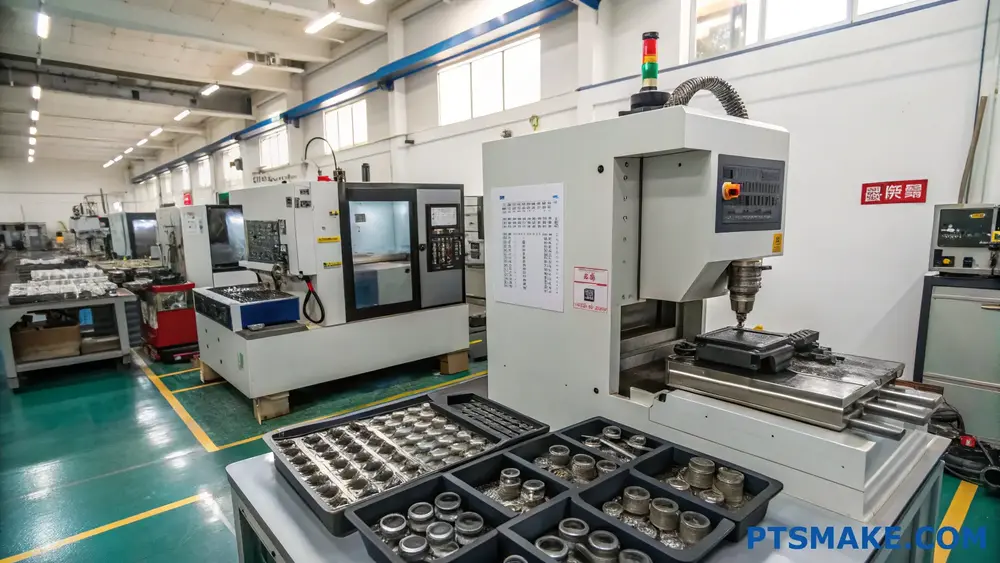
Key Factors for Evaluating Chinese CNC Manufacturers
When determining if a Chinese CNC shop can handle your entire production cycle, from prototype to mass manufacturing, you need to evaluate several critical factors. I’ve helped hundreds of clients navigate this decision, and these are the most important considerations:
Equipment Versatility and Capabilities
The machinery a shop utilizes tells you much about their capabilities. High-quality Chinese CNC shops typically maintain different types of equipment optimized for various production scales:
- Prototype-focused machines: Smaller, highly flexible CNC machines that can be quickly reconfigured for one-off or small batch production
- Production-oriented equipment: Larger, often multi-axis automated systems designed for consistent, high-volume output
- Hybrid capabilities: The ability to transition between these equipment types as your project scales
At PTSMAKE, we’ve invested in both specialized prototype equipment and production-scale machinery, which allows us to maintain continuity as projects evolve from concept to mass production.
Quality Control Systems Across Production Scales
Consistent quality is perhaps the most crucial factor. Look for manufacturers with:
- Documented QC procedures for both prototype and mass production stages
- ISO 9001 certification (minimum) and industry-specific certifications
- Statistical Process Control5 implementation for mass production
- Precision measurement equipment appropriate for your tolerance requirements
- Clear documentation of inspection methodologies
The most reliable Chinese shops will have separate QC protocols for prototypes versus mass production, while maintaining consistent standards across both.
Team Structure and Communication Processes
The organizational structure of a CNC shop significantly impacts their ability to handle different production scales:
| Production Phase | Key Personnel | Communication Requirements |
|---|---|---|
| Prototyping | Engineers, Technical Specialists | Frequent changes, detailed feedback |
| Small Batch | Production Supervisors, Quality Managers | Process validation, improvement cycles |
| Mass Production | Production Managers, Automation Specialists | Efficiency reports, consistency checks |
When evaluating suppliers, I always check if they have dedicated teams for both prototype and mass production, or if they use a unified approach with cross-trained staff.
Scalable Pricing Models
Reputable Chinese CNC manufacturers will offer transparent pricing structures that scale logically:
- Prototype pricing that accounts for engineering time and setup costs
- Small batch rates that begin to reduce per-unit costs
- Volume discounts that reflect genuine economies of scale
- Material purchase optimization at different quantities
Be wary of shops that quote extremely low mass production prices but high prototype costs, or vice versa—this often indicates they’re specialized in only one type of production.
Transition Management Between Prototype and Production
The bridge between prototype and mass production is where many projects encounter problems. The best Chinese CNC partners implement structured transition processes:
Design for Manufacturability (DFM) Analysis
Quality suppliers conduct thorough DFM reviews at each production stage:
- Initial prototype DFM focuses on feasibility and design intent
- Pre-small batch DFM addresses optimization and consistency
- Mass production DFM emphasizes efficiency, tool life, and cost reduction
This staged approach ensures designs evolve appropriately for each production phase.
Tooling and Fixture Evolution
The most capable Chinese CNC shops approach tooling differently across production scales:
- Prototype phase: Flexible, adaptable tooling that can accommodate design changes
- Small batch phase: Semi-dedicated fixtures that balance flexibility with efficiency
- Mass production: Custom, optimized tooling designed for maximum throughput and consistency
In my experience, how a manufacturer handles this tooling evolution reveals much about their true capabilities.
Process Documentation and Knowledge Transfer
Pay attention to how the manufacturer documents processes and transfers knowledge between production phases:
- Do they maintain detailed records from prototype through production?
- Can they provide examples of previous successful scale-ups?
- Is there a formal process for transferring prototype learning to production teams?
The most reliable partners will have robust systems for ensuring continuity throughout your product’s lifecycle.
Red Flags vs. Green Lights When Assessing Chinese CNC Manufacturers
Based on my experience working with various Chinese manufacturers, here are clear indicators to help you evaluate potential partners:
Warning Signs (Red Flags)
- Drastically different quality samples between prototype and mass production examples
- Unwillingness to discuss or show both prototype and production facilities
- Vague answers about capacity utilization and scheduling
- No clear process for managing engineering changes across production scales
- Separate, disconnected teams handling different production phases with poor communication
Positive Indicators (Green Lights)
- Integrated ERP/MES systems that track projects from prototype through production
- Samples demonstrating consistent quality across different production volumes
- Detailed discussion of how processes adapt as quantities increase
- Clear communication about appropriate lead times for different production phases
- Evidence of successful transitions from prototype to mass production for similar projects
At PTSMAKE, we’ve developed specific workflows to ensure seamless transitions as projects scale, which has proven critical for clients who need long-term manufacturing partnerships.
Material Selection in China CNC Machining: Balancing Performance and Cost?
Have you ever felt overwhelmed by the vast array of material options when planning your CNC machining project? Perhaps you’ve struggled to determine which surface treatments would best protect your parts while meeting your budget constraints? The wrong choice can lead to premature part failure, unexpected costs, or production delays.
Chinese CNC machining services offer a comprehensive range of materials including metals (aluminum, steel, copper), plastics (ABS, PC, PEEK), and various surface treatments like anodizing, powder coating, and plating. Material selection should balance functional requirements, cost considerations, and production volume to achieve optimal performance.
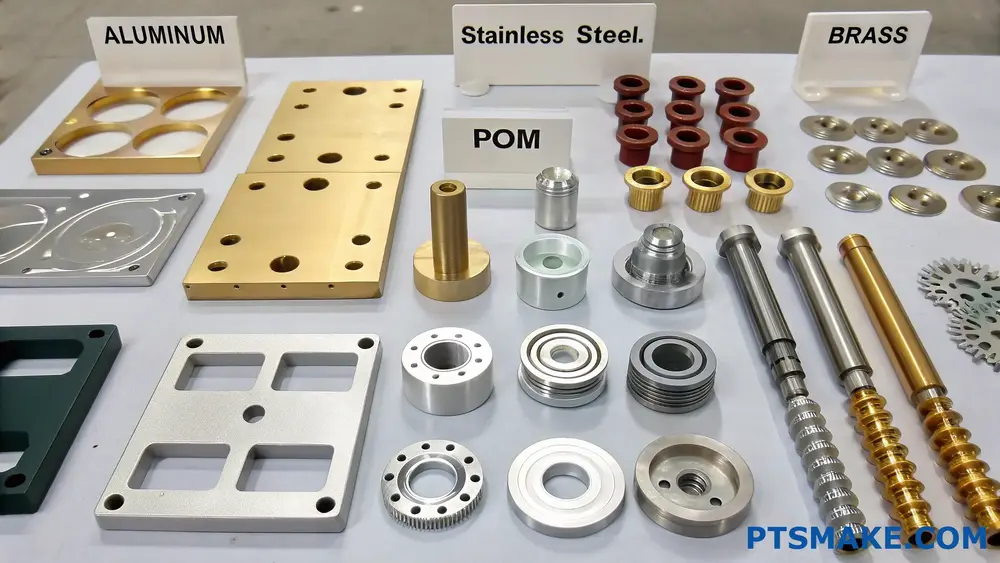
Available Materials in China CNC Machining
When sourcing CNC machined parts from China, understanding the full spectrum of available materials is crucial for project success. I’ve found that working with Chinese manufacturing partners gives you access to virtually all industry-standard materials, often at competitive prices due to the country’s robust supply chain infrastructure.
Metal Materials
Metals remain the backbone of precision CNC machining in China, with several options available to suit different applications:
Aluminum Alloys
Aluminum alloys, particularly 6061 and 7075, are among the most commonly machined materials in Chinese CNC shops. Their excellent machinability, high strength-to-weight ratio, and good corrosion resistance make them ideal for various applications.
For aerospace and high-performance mechanical applications, I often recommend 7075 aluminum for its superior strength, while 6061 works well for general-purpose components where cost is a factor. Chinese manufacturers have extensive experience with these materials, ensuring consistent quality and tight tolerances.
Steel Varieties
The range of steel options available through Chinese CNC services is extensive, including:
- Stainless Steel: Grades 303 and 304 offer excellent corrosion resistance and are widely used for food processing equipment, medical devices, and outdoor applications.
- Tool Steel: D2, A2, and other grades provide exceptional hardness and wear resistance for tooling applications.
- Carbon Steel: 1045 and 4140 steel offer good machinability with moderate hardness and strength.
Steel machining requires specialized expertise due to its hardness, but many Chinese manufacturers have invested in advanced tooling and cooling systems to handle these materials efficiently.
Copper, Brass, and Bronze
These non-ferrous metals offer excellent electrical conductivity, thermal properties, and corrosion resistance. Chinese CNC shops can machine these materials to high precision for electrical components, decorative items, and hydraulic fittings.
Engineering Plastics
The plastics machining capabilities in China have expanded significantly, with many facilities specializing in high-performance engineering plastics:
- ABS, POM (Delrin), and Nylon: Common for prototypes and end-use parts requiring good mechanical properties.
- PEEK, PPS, and PTFE: High-performance plastics available for demanding applications requiring chemical resistance, high-temperature stability, or self-lubricating properties.
- Polycarbonate (PC) and Acrylic: Transparent materials ideal for optical components and displays.
Many Chinese manufacturers can source these specialized materials through established supply networks, making even exotic plastics readily available for your projects.
Surface Treatments and Finishes Available in China
Surface treatments are critical for enhancing part performance, appearance, and longevity. Chinese CNC machining services offer a comprehensive range of surface treatments6 that can be applied to machined components.
Metal Surface Treatments
Anodizing
Anodizing is widely available for aluminum parts, creating a hard, corrosion-resistant oxide layer that can be dyed in various colors. Type II and Type III (hard anodizing) processes are common, with many facilities offering tight color matching for aesthetic applications.
Plating Processes
Chinese manufacturers offer numerous plating options:
| Plating Type | Key Benefits | Common Applications |
|---|---|---|
| Nickel | Corrosion resistance, hardness | Industrial components, electronics |
| Chrome | Wear resistance, low friction | Automotive parts, tooling |
| Zinc | Cost-effective corrosion protection | Fasteners, structural components |
| Gold | Electrical conductivity, corrosion resistance | Electronic connectors, aerospace |
Heat Treatment
Heat treatment services for hardening, tempering, and stress relieving are readily available, particularly for steel components. These processes improve material properties like hardness, strength, and dimensional stability.
Surface Finishes for Plastics
For plastic components, Chinese manufacturers offer:
- Painting and coating: Including specialized UV-resistant coatings
- Texturing: Various patterns and surface textures for improved grip or appearance
- Polishing: From matte to mirror finishes
Chemical Treatments
Various chemical processes are available to enhance material properties:
- Passivation: For stainless steel to enhance corrosion resistance
- Black oxide: For steel components, providing moderate corrosion protection
- Chemical film treatments: Including chromate conversion coatings
Material and Treatment Selection Considerations
When working with Chinese CNC machining partners, I recommend considering several factors to optimize your material and surface treatment choices:
Application Requirements
Start by clearly defining the mechanical, thermal, chemical, and environmental requirements your part will face. For example, parts exposed to harsh outdoor conditions might benefit from stainless steel with passivation rather than carbon steel with plating.
Cost Implications
Material selection significantly impacts your project cost. In my experience working with Chinese manufacturers, aluminum typically costs 3-5 times less than stainless steel for the same component, while engineering plastics like PEEK can cost substantially more than standard plastics like ABS.
Consider these approximate relative cost factors:
| Material Category | Relative Cost Factor | Machining Complexity |
|---|---|---|
| Standard Plastics (ABS, POM) | 1x | Low to Medium |
| Aluminum Alloys | 1.5-2x | Low |
| Carbon Steel | 2-3x | Medium |
| Stainless Steel | 3-5x | High |
| High-Performance Plastics (PEEK) | 5-10x | Medium |
| Titanium | 10-15x | Very High |
Production Volume Considerations
The production volume can influence both material and surface treatment choices. For high-volume production, materials with better machinability might be preferred to reduce cycle times and tooling wear, even if the raw material cost is slightly higher.
Supply Chain Reliability
While China has robust supply chains for most materials, lead times for specialized materials can vary. I’ve found it beneficial to discuss material availability early in the project planning stage with your manufacturing partner to avoid unexpected delays.
Quality Assurance for Materials and Treatments
To ensure the materials and treatments meet your specifications, consider implementing these measures:
- Material certification: Request material certificates that verify chemical composition and mechanical properties.
- Treatment verification: Specify testing methods for surface treatments (e.g., coating thickness, hardness testing).
- Sample evaluation: Request treated samples before full production to verify appearance and performance.
By understanding the material and surface treatment options available through Chinese CNC machining services, you can make informed decisions that balance performance requirements, aesthetics, and cost considerations for your projects.
How About After Sale Of Chinese CNC Machining?
Have you ever ordered precision parts from China, only to discover issues after delivery? The excitement of receiving your shipment quickly turns to frustration when problems arise and your supplier seems to disappear. This scenario plays out more often than you might think, leaving many engineers and procurement managers feeling abandoned.
After-sales service for Chinese CNC machining typically includes technical support, warranty coverage, quality issue resolution, replacement parts, and ongoing maintenance assistance. The best Chinese suppliers maintain dedicated after-sales teams, offer comprehensive warranties, and provide responsive communication channels throughout your product lifecycle.
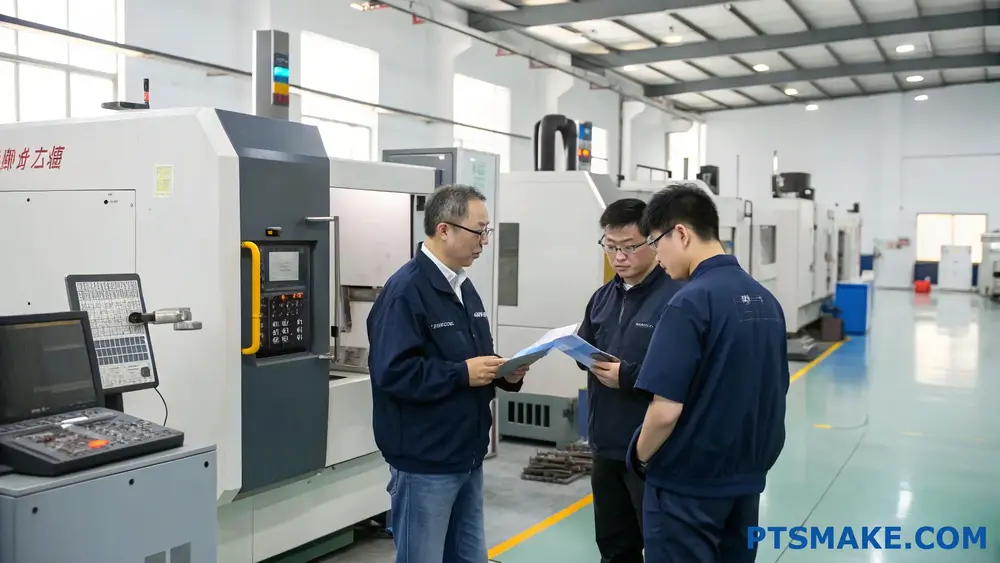
Understanding the Importance of After-Sales Support in CNC Machining
When sourcing CNC machined parts from China, many buyers focus primarily on initial factors like pricing, lead times, and quality certifications. However, the true measure of a manufacturing partner often reveals itself after you’ve received your order. After-sales support is a critical aspect that can make or break your overall experience with a Chinese supplier.
After-sales service encompasses everything that happens after you receive your parts – from addressing quality concerns to providing technical support and handling warranty claims. It’s essentially your safety net when issues inevitably arise.
In my experience working with hundreds of clients at PTSMAKE, I’ve found that robust after-sales support is often what transforms a one-time transaction into a lasting partnership. It’s not just about fixing problems; it’s about demonstrating commitment to your success beyond the initial sale.
Key Components of Quality After-Sales Service
Technical Support and Consultation
A reputable Chinese CNC machining supplier should offer ongoing technical consultation even after your order is complete. This might include:
- Design modification suggestions for future orders
- Material selection guidance based on part performance
- Manufacturing process optimization recommendations
- Post-processing consultation7 for surface treatments and finishes
At PTSMAKE, we maintain a team of engineers specifically dedicated to providing technical support for clients long after their parts have been delivered. This ensures you have access to expertise whenever new challenges arise.
Comprehensive Warranty Coverage
Warranty terms can vary significantly among Chinese suppliers, so it’s essential to understand exactly what’s covered before placing an order. A quality supplier typically offers:
| Warranty Element | Industry Standard | Premium Service |
|---|---|---|
| Duration | 3-6 months | 12+ months |
| Coverage Scope | Dimensional accuracy | Functionality, material, finish |
| Response Time | Within 7 days | Within 24-48 hours |
| Resolution Methods | Replacement only | Replacement, repair, or refund |
The most reliable suppliers stand behind their work with clear, written warranty terms that provide real protection against manufacturing defects.
Quality Issue Resolution Process
How a supplier handles quality concerns speaks volumes about their professionalism and commitment to customer satisfaction. Look for providers with:
- A structured quality claim procedure
- Prompt acknowledgment of reported issues
- Clear documentation requirements
- Multiple resolution options (rework, replacement, credit)
- Root cause analysis to prevent recurrence
When quality issues arise at PTSMAKE, we follow a systematic approach that emphasizes transparency and collaboration. This means you’ll never be left in the dark about the status of your claim or the proposed solution.
Spare Parts and Replacements
For complex assemblies or ongoing production needs, access to replacement components is crucial. Quality suppliers maintain:
- Inventory of common replacement parts
- Documentation of your specific part specifications
- Ability to reproduce components with consistent quality
- Expedited manufacturing for urgent replacement needs
This capability ensures minimal disruption to your operations when components need replacement.
Red Flags in After-Sales Service
While many Chinese CNC machining suppliers promise excellent after-sales support, certain warning signs may indicate potential issues:
Communication Barriers
- Delayed responses to inquiries (more than 24-48 hours)
- Unwillingness to use video calls for complex issue resolution
- Language barriers without proper translation support
- Limited communication channels (email only, no phone support)
Unclear Responsibility Assignment
- No dedicated after-sales contact person
- Constant redirection between departments
- Inability to escalate issues to management
- Confusion about who handles specific types of problems
Resistance to Documentation
- Unwillingness to provide written warranty terms
- Reluctance to document quality issues
- No formal process for submitting claims
- Verbal promises without written confirmation
Building a Relationship-Based After-Sales Experience
The most successful client-supplier relationships in CNC machining go beyond transactional interactions. They’re built on mutual trust and ongoing communication. Here’s how to cultivate this type of relationship:
Regular Performance Reviews
Scheduling quarterly or semi-annual reviews with your supplier creates opportunities to:
- Discuss recent project successes and challenges
- Address any recurring quality or service issues
- Share upcoming project needs and expectations
- Strengthen personal connections with key contacts
Clear Communication Protocols
Establishing communication expectations from the beginning helps prevent misunderstandings:
- Define preferred communication channels for different situations
- Set response time expectations for various issue types
- Identify emergency contact procedures for urgent problems
- Create documentation standards for technical communications
Cultural Understanding
Working effectively with Chinese suppliers requires appreciating cultural differences in business communication:
- Building relationships before focusing solely on problems
- Understanding indirect communication styles
- Recognizing the importance of "face" in problem resolution
- Appreciating time zone differences and holiday schedules
How to Evaluate After-Sales Service Before Ordering
Before committing to a Chinese CNC machining supplier, take these steps to assess their after-sales capabilities:
- Request references from long-term clients specifically about after-sales support
- Ask detailed questions about their quality issue resolution process
- Review written warranty terms and conditions
- Test their responsiveness during the quoting and sampling phase
- Inquire about their dedicated after-sales team structure
Remember that the lowest price often comes with the poorest after-sales support. Investing in a slightly higher-priced supplier with excellent service capabilities frequently proves more economical in the long run when considering the total cost of ownership.
What Industries Benefit Most From China’s CNC Machining Capabilities?
Have you ever wondered why so many global companies source their precision components from China? Are you struggling to identify which industries truly leverage Chinese CNC machining to gain competitive advantages in today’s fast-paced manufacturing landscape?
China’s CNC machining capabilities benefit multiple industries, with aerospace, automotive, medical, electronics, and robotics gaining the most advantage. These sectors leverage China’s combination of cost efficiency, technological advancement, and skilled workforce to produce complex, high-precision components at scale.
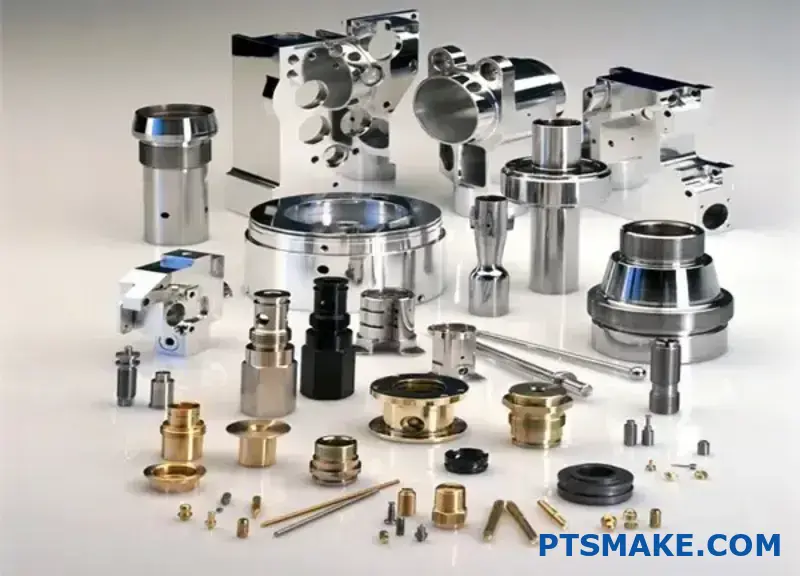
Aerospace Industry: Precision at High Altitudes
The aerospace industry stands as perhaps the most significant beneficiary of China’s CNC machining capabilities. Aircraft components demand exceptional precision, reliability, and consistent quality – areas where Chinese manufacturing has made remarkable strides.
Critical Aerospace Applications
In aerospace manufacturing, tolerances are measured in microns, and materials must withstand extreme conditions. Chinese CNC facilities excel at producing:
- Turbine blades with complex airfoil geometries
- Lightweight structural components from aluminum alloys
- Engine housing components requiring tight tolerances
- Navigation system housings with complex internal features
I’ve collaborated with several aerospace suppliers who initially expressed skepticism about Chinese manufacturing capabilities. However, after witnessing the metrological verification8 process at PTSMAKE’s facilities, they’ve become regular partners. The combination of advanced 5-axis CNC machines with rigorous quality control systems makes Chinese suppliers particularly valuable for aerospace applications.
Automotive Industry: Driving Innovation
The automotive sector’s relationship with Chinese CNC machining has evolved dramatically over the past decade. What began as simple component sourcing has developed into comprehensive manufacturing partnerships.
High-Performance Components
Modern vehicles contain hundreds of precision-machined parts. China’s CNC capabilities are especially valuable for:
- Transmission components requiring complex geometries
- Cylinder heads with intricate cooling channels
- Brake system components demanding high dimensional stability
- Custom performance parts for racing applications
The automotive industry particularly benefits from China’s ability to scale production efficiently. When a component moves from prototype to mass production, Chinese manufacturers can rapidly deploy additional capacity while maintaining quality standards – a capability I’ve seen repeatedly benefit our automotive clients.
Medical Device Manufacturing: Precision Meets Compliance
Perhaps no industry has higher standards for component quality than medical device manufacturing. The growth of China’s capabilities in this sector has been remarkable.
Medical Applications
Chinese CNC machining excels in producing:
| Component Type | Material Commonly Used | Typical Tolerances | Key Requirements |
|---|---|---|---|
| Surgical Instruments | Stainless Steel | ±0.005mm | Biocompatibility, Finish Quality |
| Implantable Devices | Titanium Alloys | ±0.01mm | Surface Finish, Material Purity |
| Diagnostic Equipment | Aluminum, Plastics | ±0.02mm | Dimensional Stability |
| Orthopedic Fixtures | Medical-grade Titanium | ±0.015mm | Strength, Biocompatibility |
What’s particularly impressive is how Chinese manufacturers have embraced international medical standards like ISO 13485. At PTSMAKE, we’ve invested heavily in clean manufacturing environments and specialized inspection equipment specifically for our medical device clients.
Electronics Industry: Miniaturization Masters
The electronics industry represents another major beneficiary of China’s CNC capabilities, particularly as devices continue to shrink while becoming more complex.
Precision Electronic Components
Chinese CNC machining is integral to producing:
- Heat sinks with optimized thermal dissipation properties
- Connector housings with precise pin alignment requirements
- Smartphone chassis components with tight tolerances
- Testing fixtures for semiconductor manufacturing
The electronics industry values China’s ability to work with diverse materials – from traditional aluminum to specialized copper alloys and engineering plastics. This material versatility, combined with precision machining, makes Chinese suppliers particularly valuable for electronics manufacturers pushing the boundaries of miniaturization.
Robotics and Automation: The Future of Manufacturing
As robotics technology advances, the demand for precision-machined components has skyrocketed. Chinese CNC capabilities align perfectly with the robotics industry’s needs.
Robotics Applications
Key components commonly sourced from Chinese CNC suppliers include:
- Robotic joint mechanisms requiring precise geometric control
- End-effector components with complex mounting interfaces
- Sensor mounting brackets with precise alignment features
- Structural frame components balancing strength and weight
The robotics industry particularly benefits from the iterative development capabilities of Chinese manufacturers. As designs evolve through multiple prototyping rounds, having a manufacturing partner who can quickly adapt to design changes provides significant competitive advantages.
Renewable Energy: Powering Sustainability
The renewable energy sector has emerged as a major beneficiary of Chinese CNC capabilities, particularly in wind and solar power systems.
Wind turbine components and solar tracking mechanisms require both precision and durability in challenging outdoor environments. Chinese manufacturers have developed specialized expertise in machining the large, complex components these industries require, often at more competitive costs than Western alternatives.
What Makes Chinese CNC Machining Particularly Valuable?
While examining these industries, several common themes emerge that explain why China’s CNC capabilities provide particular advantages:
Scale and capacity: Few regions can match China’s manufacturing capacity, enabling production scaling from prototype to high volume.
Technical specialization: Many Chinese CNC shops focus exclusively on specific industries, developing deep expertise in those sectors’ unique requirements.
Material diversity: The ability to machine everything from standard alloys to exotic materials provides flexibility for innovative designs.
Cost-effective precision: The combination of advanced equipment with competitive labor rates creates an attractive value proposition.
The diversity of industries benefiting from Chinese CNC capabilities continues to expand, but these core sectors demonstrate where the most significant advantages are found. As manufacturing continues to evolve globally, China’s role as a precision machining hub shows no signs of diminishing.
Learn about proper handling requirements for CNC production safety. ↩
Click to learn how concentrated manufacturing clusters reduce costs dramatically. ↩
Learn exactly how surface finish affects machining time and cost. ↩
Learn about specialized language adaptation techniques for technical manufacturing communications. ↩
Learn about this vital manufacturing control method for maintaining quality at scale. ↩
Click for a detailed guide on selecting optimal surface treatments for your specific application. ↩
Expert guidance on treatments applied after the main machining process is complete. ↩
Understanding this verification process helps improve component quality. ↩



